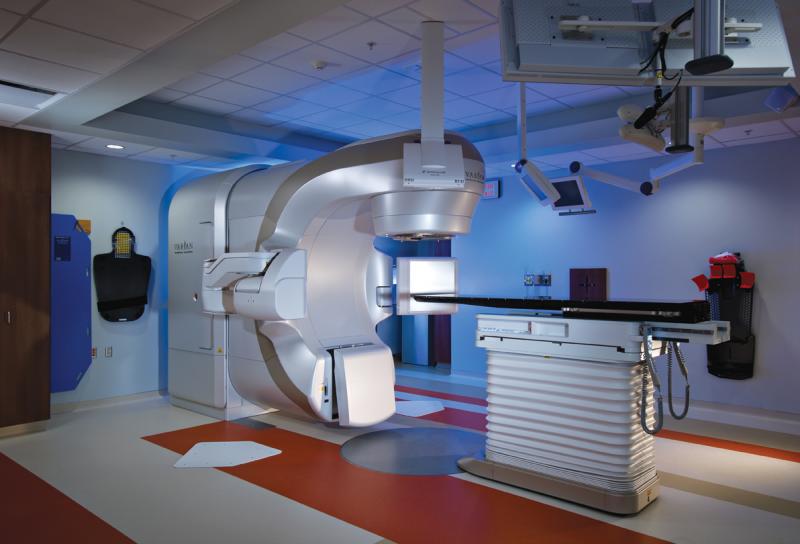Patients receiving radiotherapy (RT) for cancers in the pelvic region can experience diarrhea, a negative side effect of radiation treatment. Sulfasalazine, an oral tablet used to treat inflammation of the bowels, had been shown in a past trial of 31 patients to decrease diarrhea during pelvic RT. Sulfasalazine does not reduce diarrhea, according to research presented today at the American Society of Radiation Oncology’s (ASTRO’s) 55th Annual Meeting. The study also determined that the medication might be associated with a higher risk of diarrhea than placebo.
Clinicians face the challenge of effectively imaging larger patients. Recognizing this trend, Esaote’s new eHD Technology improves every element of the imaging chain and increases ultrasound’s ability to image with more clarity at greater depth.
ClinicalKey, a clinical insight engine, is an online clinical information resource that provides radiologists with access to Elsevier's radiology references at point of care for guidance on every aspect of the field.
While most women understand the importance of health screenings, an estimated 72 million have missed or postponed a ...
Eizo Corp. released the RadiForce MX215, a 21.3-inch color LCD monitor for clinical review.
Reporting is one of the areas in medical imaging informatics that has advanced the most in recent years. With much of the imaging workflow now digitized and carried out through second-, if not third-generation image and information management systems such as picture archiving and communication systems (PACS) or radiology information systems (RIS), the ”third pillar” of the end-to-end digital imaging workflow has grown less isolated and more influential than ever before — signaling the advent of true voice-enabled and speech-driven radiology reporting.

SPONSORED CONTENT — Fujifilm’s latest CT technology brings exceptional image quality to a compact and user- and patient ...
Treatment planning systems have been an integral part of radiation therapy since the 1980s; however, today’s systems are more technologically advanced. Back then dosimetrists would sit in front of a computer all day long contouring and planning out treatments for patients. Afterward, physicians and physicists would review the plans. Although the fundamental workflow has not changed much, as technology improves, new features are continually added to the systems to allow physicians to get more out of them than ever before.
Fujifilm’s APERTO Lucent is a 0.4T mid-field, open MRI system addressing today’s capability and image quality needs ...
Since opening in September 2011, the Banner MD Anderson Cancer Center has become a premier regional center for cancer patients in the greater Phoenix area. With some of the latest state-of-the-art technology in place, the Gilbert, Ariz., facility prides itself on offering patients the same level of care that they would receive at the University of Texas MD Anderson Cancer Center. “The philosophy is to treat patients with the same protocols and philosophy that they would get as if they went to Houston,” said Stephen Sapareto, Ph.D., DABR, director of medical physics, division of radiation oncology, Banner MD Anderson Cancer Center.
Whole-body magnetic resonance imaging (MRI) may serve as a valuable noninvasive tool for assessing the risk of heart attack and stroke in diabetic patients, according to a new clinical study published online in the journal Radiology.
The addition of magnetic resonance (MR) imaging and spectroscopy to positron emission tomography (PET) is more expensive and more technically challenging compared with PET/computed tomography (CT). PET/CT is successful because the inclusion of CT has major advantages: accurate lesion localization, the identification of non-PET avid lesions and effective attenuation correction in a rapid, efficient combined examination. The addition of CT is particularly valuable for lungs and liver, where fluorodeoxyglucose (FDG) PET is limited by spatial resolution and relatively low target-to-background differential biodistribution. Presumably, PET/MR may disclose unique important diagnostic and prognostic information in selected patient groups.
SPONSORED CONTENT — Fujifilm’s latest CT technology brings exceptional image quality to a compact and user- and patient ...
During the American College of Cardiology 2013 (ACC.13) annual meeting in March, vendors discussed several trends they are observing in the cardiac ultrasound market and displayed the latest echo advances.
Imaging the World (ITW) was founded in 2008. Its mission is to bring medical expertise and high-quality, low-cost health care to most remote and under-served areas worldwide by integrating simple ultrasound technology with training, local capacity building and community support. It is much more than modern technology alone — it is a system solution.
With concerns about radiation dose and reducing unnecessary imaging scans, advances in computed tomography (CT) systems have brought about technologies such as iterative reconstruction software, intraoperative capabilities and dose-tracking software. In addition, recent studies on the use of CT on select patient populations and the modality’s benefits in detecting certain cancers are showing that the risks of CT imaging can go both ways. While CT exams can add to a patient’s lifetime exposure to ionizing radiation, they can also be more beneficial in cases where magnetic resonance imaging (MRI) or ultrasound might not be able to detect early-stage cancers. Some of these trends in utilization indicate that appropriate low-dose CT imaging will be key across patient populations.
SPONSORED CONTENT — EnsightTM 2.0 is the newest version of Enlitic’s data standardization software framework. Ensight is ...
Based on its recent analysis of the molecular imaging market, Frost & Sullivan recognizes Siemens Healthcare with the 2013 North American Frost & Sullivan Award for Company of the Year. Siemens Healthcare has dedicated equal attention and resources to the development of both single-photon emission computed tomography (SPECT) and positron emission tomography (PET) imaging – the two pillars of molecular imaging. The company has moved quickly to innovate and strategize in a rapidly evolving market to secure for itself an ideal market position.
ITN is proud to go pink this month in an effort to help bring attention to Breast Cancer Awareness Month. This disease all too often hits home with the imaging and radiation oncology markets.

SPONSORED CONTENT — EnsightTM 2.0 is the newest version of Enlitic’s data standardization software framework. Ensight is ...
This year at RSNA 2013, GE Healthcare will showcase its SenoBright Contrast Enhanced Spectral Mammography (CESM) technology designed to produce contrast-enhanced images of the breast using an approved X-ray contrast agent and a dual energy acquisition technique. This technology is experiencing increased adoption globally and in the United States, and GE Healthcare will present, in its booth, an informational campaign designed for American women with a history of breast cancer and their relatives, and those who want to know about the latest options in diagnostics.
Limiting the amount of radiation absorbed in the hippocampal portion of the brain during whole-brain radiotherapy (WBRT) for brain metastases preserves memory function in patients for up to six months after treatment according to research presented at the American Society for Radiation Oncology’s (ASTRO’s) 55th Annual Meeting.
At RSNA 2013, GE Healthcare will highlight the latest hardware and advanced applications for its Discovery IGS angiography platform. These updates are geared towards addressing the challenges of healthcare providers, support clinical decision making and helping clinicians in refining overall patient care.
Ascendian Healthcare Consulting announced a new service line to assist clients with ensuring the confidentiality, integrity and availability of patient data — the medical imaging client’s privacy, data security and patient safety consulting services.
A study by Cutting Edge Information found that pharmaceutical companies measure cost per patient per month to allow trials of different sizes and durations to be compared easily. This measurement also helps to illustrate the high costs associated with delays.
The U.S. Senate passed legislation Sept. 26 to reauthorize, extend and improve operations of the Federal Helium Reserve in Texas, which will guarantee a stable supply of the gas used for cooling magnetic resonance imaging (MRI) systems.


 October 01, 2013
October 01, 2013 

















